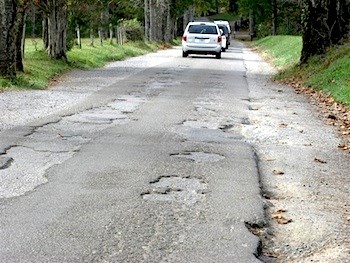Transportation Management SystemsThe NPS Transportation Program uses four management systems as important decision support tools. These systems provide parks and regions with basic condition, performance, and cost information to help set priorities when setting budgets for park unit proposals. The four management systems are being jointly developed by the National Park Service and the Federal Lands Highway Office.
Pavement Management SystemThis system helps identify potential road resurfacing, rehabilitation, and reconstruction projects, and assists transportation managers in in making informed decisions when selecting projects. The pavement management system uses data from the Road Inventory Program (RIP), which includes condition and inventory information on park unit roads. The Road Inventory Program collects data by use of an automated road analyzer, which:
Roads:The 2016 publicly accessible paved road network Pavement Condition Rating (PCR), an FHWA-developed, industry standard condition metric, showed NPS roads at 82, indicating a network-wide "fair condition" for its pavements. The ideal condition under sound asset management practices would be to improve the system and maintain it at a PCR of 85 (the lowest PCR still in "good condition"), which allows for a network of paved roads which can be efficiently maintained with pavement preservation and a complete array of maintenance and rehabilitation strategies. Preventive Treatments:To maintain the roads and bridges now listed in "good condition"—and successfully protect NPS transportation investments—the Federal Lands Transportation Program (FLTP) must implement an aggressive preventive maintenance program. This would extend the life of these facilities, and ultimately save substantial dollars by avoiding full reconstruction costs. A dollar spent on preventive maintenance can save $3-$5 in the future, so a lack of annual investment in preventative maintenance will only cost more in the long term.
Bridge Management SystemThe bridge management system is intended to improve decision making about the type and priority of bridge investments, based on inspection data now collected as part of the Bridge Inspection Program (BIP). For more than 20 years, NPS staff has collected condition data on all bridge structures greater than 20 feet in length. Under this inspection program, the following occurs:
Bridges:The NPS bridge inventory had a Bridge Health Index of 0.92 in 2016. The NPS bridge inventory has a number of bridges constructed in the 1940s, 50s, and 60s. The 2010 assessment reported 46 publicly accessible NPS bridges in need of rehabilitation or reconstruction. Protecting the NPS bridge inventory requires strategies that identify and address these deficiencies.
Transportation Safety Management SystemThe Transportation Safety Management System (TSMS) is an important component of the NPS Transportation Safety Program. The TSMS is the systematic processes for providing actionable safety decision-making information, primarily for NPS parks and regions. The TSMS includes the multidisciplinary processes whereby internal and external safety practitioners and stakeholders cooperate, coordinate, communicate, and partner in strategic planning, safety data collection, safety data analysis, performance management, and evaluation to make data driven recommendations. TSMS Multidisciplinary Processes:
Actionable Transportation Safety decision-making information:

Congestion Management SystemThe 1998 legislation also required the development of a congestion management system, which an NPS/FLH team is implementing in stages. One important assumption of a congestion management system for national parks is that, for leisure travel in a park environment, congestion may involve other factors and user perceptions than those for a commuter whose primary concern is time lost in traffic.In its initial stages, NPS and FLH staff are collecting basic traffic data and assessing traffic conditions, as well as visitor experience gauged from annual park surveys. At the same time, NPS Washington Office staff and Western FLH division staff are studying factors that might produce a special level of service standard for parks called the composite level of service. When completed, the study should provide a method to identify priority congestion-related projects affecting NPS and other federal land management agencies. The composite measure should also help state transportation departments that are struggling to preserve scenic byways and make them accessible to a growing number of visitors. |
Last updated: January 10, 2023
